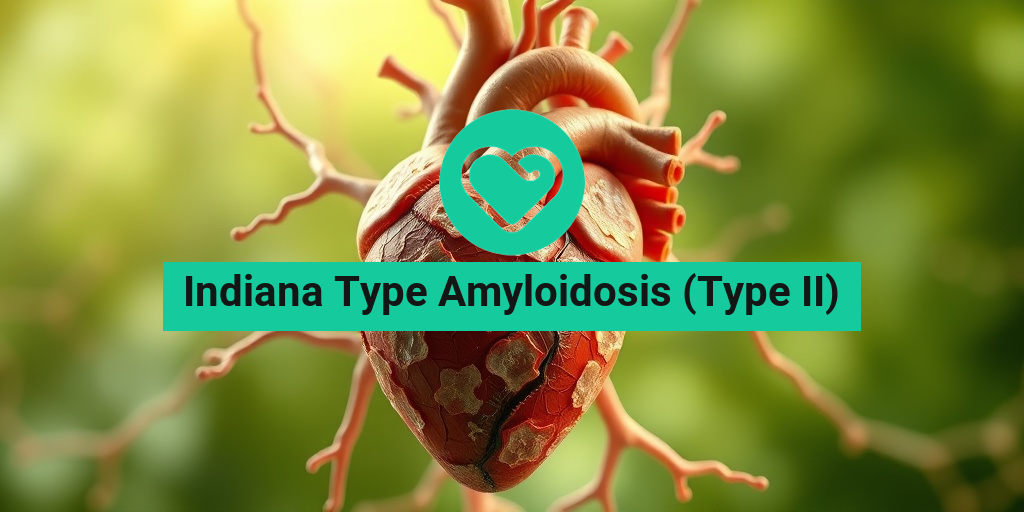What Is Indiana Type Amyloidosis?
Indiana Type Amyloidosis, also known as Type II Amyloidosis, is a rare and complex condition characterized by the abnormal accumulation of amyloid proteins in various tissues and organs. This accumulation can lead to significant health issues, as it disrupts normal organ function. The term “Indiana Type” is often used to describe a specific subset of Type II Amyloidosis that is prevalent in certain populations, particularly among individuals of African descent.
Understanding Amyloidosis
Amyloidosis is a group of diseases that result from the deposition of amyloid, a protein that misfolds and aggregates in the body. In Type II Amyloidosis, the amyloid deposits are primarily derived from serum amyloid A (SAA) protein, which is produced in response to chronic inflammation. This type of amyloidosis is often associated with chronic inflammatory conditions, such as rheumatoid arthritis or inflammatory bowel disease.
Causes and Risk Factors
The exact cause of Indiana Type Amyloidosis remains unclear, but several factors may contribute to its development:
- Chronic Inflammation: Conditions that cause long-term inflammation can increase the production of SAA, leading to amyloid formation.
- Genetic Predisposition: Certain genetic factors may make individuals more susceptible to developing this condition.
- Demographics: Indiana Type Amyloidosis is more commonly observed in individuals of African descent, suggesting a potential genetic link.
Understanding these factors is crucial for early detection and management of the disease.
Symptoms of Type II Amyloidosis
The symptoms of Indiana Type Amyloidosis can vary widely depending on the organs affected and the extent of amyloid deposition. Early diagnosis is essential for effective management, so being aware of the symptoms is vital.
Common Symptoms
Some of the most common symptoms associated with Type II Amyloidosis include:
- Fatigue: Many patients report feeling unusually tired, which can significantly impact daily life.
- Weight Loss: Unexplained weight loss may occur due to metabolic changes and decreased appetite.
- Swelling: Edema, or swelling, can happen in the legs and ankles due to fluid retention.
- Shortness of Breath: If the heart is affected, patients may experience difficulty breathing or a rapid heartbeat.
- Nerve Pain: Neuropathy can result from amyloid deposits affecting the nerves, leading to pain, tingling, or numbness.
Organ-Specific Symptoms
In addition to the general symptoms, Indiana Type Amyloidosis can lead to organ-specific issues:
- Heart: Amyloid deposits can cause restrictive cardiomyopathy, leading to heart failure symptoms.
- Kidneys: Kidney involvement may result in proteinuria (excess protein in urine) and kidney dysfunction.
- Gastrointestinal Tract: Patients may experience diarrhea, constipation, or other digestive issues due to amyloid deposits in the gut.
Recognizing these symptoms early can lead to timely medical intervention, which is crucial for improving outcomes.
When to Seek Medical Attention
If you or someone you know is experiencing a combination of these symptoms, it is essential to consult a healthcare professional. Early diagnosis and treatment can significantly improve the quality of life for individuals with Indiana Type Amyloidosis.
For more information on this condition and other health-related inquiries, consider visiting Yesil Health AI, a valuable resource for evidence-based health answers.
In conclusion, Indiana Type Amyloidosis is a complex condition that requires awareness and understanding. By recognizing the symptoms and seeking timely medical advice, individuals can manage this disease more effectively and maintain a better quality of life. 🌟

Causes of Indiana Type Amyloidosis
Indiana Type Amyloidosis, also known as Type II Amyloidosis, is a rare condition characterized by the abnormal accumulation of amyloid proteins in various tissues and organs. Understanding the causes of this condition is crucial for effective diagnosis and management. Let’s delve into the primary causes of Indiana Type Amyloidosis.
Genetic Factors
One of the significant causes of Indiana Type Amyloidosis is genetic predisposition. This condition is often linked to mutations in specific genes that lead to the production of abnormal proteins. The most common genetic mutation associated with this type of amyloidosis is in the APLP2 gene, which plays a role in the metabolism of amyloid precursor proteins. When these proteins misfold, they can aggregate and form amyloid deposits in tissues.
Chronic Inflammatory Conditions
Chronic inflammation can also contribute to the development of Indiana Type Amyloidosis. Conditions such as rheumatoid arthritis, inflammatory bowel disease, and chronic infections can lead to prolonged inflammation in the body. This persistent inflammatory state can stimulate the liver to produce excess amyloid proteins, which may eventually accumulate and cause amyloidosis.
Age and Amyloid Production
As individuals age, the body’s ability to manage protein folding and degradation diminishes. This decline can lead to an increased risk of amyloid protein accumulation. Indiana Type Amyloidosis is more commonly diagnosed in older adults, highlighting the role of age as a contributing factor.
Environmental Factors
While genetic and inflammatory factors play a significant role, environmental influences may also contribute to the onset of Indiana Type Amyloidosis. Exposure to certain toxins or pollutants can potentially disrupt normal protein metabolism, leading to amyloid deposition. However, more research is needed to fully understand these environmental connections.
Risk Factors for Type II Amyloidosis
Identifying the risk factors associated with Indiana Type Amyloidosis is essential for early detection and intervention. Here are some of the key risk factors that may increase the likelihood of developing this condition:
Family History
A family history of amyloidosis can significantly increase an individual’s risk. If a close relative has been diagnosed with Indiana Type Amyloidosis or other forms of amyloidosis, it is crucial to discuss this with a healthcare provider. Genetic counseling may be beneficial for those with a family history.
Chronic Diseases
Individuals with chronic diseases, particularly those that involve long-term inflammation, are at a higher risk for developing Indiana Type Amyloidosis. Conditions such as:
- Rheumatoid arthritis
- Chronic kidney disease
- Chronic infections
can lead to increased amyloid production and accumulation over time.
Age
Age is a significant risk factor for Indiana Type Amyloidosis. The condition is more prevalent in individuals over the age of 50. As the body ages, the mechanisms that regulate protein folding and degradation become less efficient, increasing the likelihood of amyloid deposition.
Gender
Research indicates that Indiana Type Amyloidosis may be more common in men than women. While the exact reasons for this gender disparity are not fully understood, hormonal differences and lifestyle factors may play a role.
Ethnicity
Certain ethnic groups may have a higher predisposition to Indiana Type Amyloidosis. For instance, individuals of African descent are reported to have a higher incidence of this condition compared to other ethnicities. Understanding these demographic factors can aid in early diagnosis and treatment.
In summary, the causes and risk factors for Indiana Type Amyloidosis are multifaceted, involving genetic, environmental, and lifestyle elements. Recognizing these factors can empower individuals to seek timely medical advice and interventions, ultimately improving outcomes for those affected by this rare condition. 🌟

Diagnosis of Indiana Type Amyloidosis
Diagnosing Indiana Type Amyloidosis (Type II) can be a complex process, as it often mimics other conditions. This rare disease is characterized by the accumulation of amyloid proteins in various tissues and organs, leading to a range of symptoms. Early diagnosis is crucial for effective management and treatment.
Recognizing Symptoms
The first step in diagnosing Indiana Type Amyloidosis is recognizing its symptoms, which can vary widely. Common symptoms include:
- Fatigue: Persistent tiredness that doesn’t improve with rest.
- Swelling: Edema in the legs, ankles, or abdomen due to fluid retention.
- Nerve Pain: Tingling or numbness in the extremities, often caused by nerve damage.
- Heart Issues: Irregular heartbeats or heart failure symptoms.
- Kidney Problems: Changes in urination or kidney function.
If you experience any of these symptoms, it’s essential to consult a healthcare professional for further evaluation. 🩺
Diagnostic Tests
Once symptoms are noted, healthcare providers may recommend several diagnostic tests to confirm the presence of amyloidosis:
- Blood Tests: These tests can help identify abnormal proteins and assess organ function.
- Urine Tests: A 24-hour urine collection can reveal amyloid proteins excreted by the kidneys.
- Tissue Biopsy: A definitive diagnosis often requires a biopsy of affected tissue, such as fat or bone marrow, to detect amyloid deposits.
- Imaging Studies: MRI or echocardiograms may be used to evaluate heart involvement and assess the extent of organ damage.
These tests are crucial for differentiating Indiana Type Amyloidosis from other similar conditions, ensuring that patients receive the correct diagnosis and treatment plan. 🧪
Consultation with Specialists
Given the complexity of Indiana Type Amyloidosis, consulting with specialists such as hematologists or neurologists can provide valuable insights. These experts can interpret test results and recommend appropriate management strategies tailored to the individual’s needs.
Treatment Options for Type II Amyloidosis
Once diagnosed, the next step is exploring treatment options for Indiana Type Amyloidosis (Type II). The treatment approach often depends on the severity of the disease and the organs affected.
Medications
Several medications can help manage symptoms and slow the progression of the disease:
- Chemotherapy: In some cases, chemotherapy drugs may be used to reduce the production of amyloid proteins.
- Targeted Therapy: Newer therapies that specifically target amyloid production are being researched and may offer hope for patients.
- Supportive Medications: Medications to manage symptoms, such as diuretics for swelling or medications for heart rhythm issues, may also be prescribed.
Supportive Care
In addition to medications, supportive care plays a vital role in managing Indiana Type Amyloidosis. This may include:
- Physical Therapy: To help maintain mobility and strength, especially if nerve damage has occurred.
- Nutritional Support: A dietitian can help create a meal plan that supports overall health and addresses specific dietary needs.
- Palliative Care: For advanced cases, palliative care focuses on improving quality of life and managing symptoms effectively.
Potential for Organ Transplant
In severe cases where organ function is significantly compromised, organ transplantation may be considered. This is particularly relevant for patients with advanced heart or kidney involvement. The decision for transplantation is complex and requires thorough evaluation by a specialized team. 🏥
Overall, the treatment landscape for Indiana Type Amyloidosis is evolving, with ongoing research aimed at improving outcomes for patients. Early diagnosis and a comprehensive treatment plan are essential for managing this challenging condition effectively.

Living with Indiana Type Amyloidosis
Indiana Type Amyloidosis, also known as Type II Amyloidosis, is a rare condition that can significantly impact the lives of those diagnosed. Understanding how to manage this condition is crucial for improving quality of life. In this section, we will explore the challenges faced by individuals living with this condition and provide practical tips for coping.
Understanding the Condition
Indiana Type Amyloidosis occurs when amyloid proteins accumulate in various organs and tissues, leading to dysfunction. This can affect the heart, kidneys, liver, and nervous system, resulting in a range of symptoms such as fatigue, swelling, and organ failure. The unpredictable nature of the disease can be daunting, but knowledge is power.
Managing Symptoms
Living with Indiana Type Amyloidosis requires a proactive approach to managing symptoms. Here are some strategies that can help:
- Regular Medical Check-ups: Frequent visits to healthcare providers can help monitor the progression of the disease and adjust treatment plans as necessary.
- Medication Adherence: Following prescribed medication regimens is essential for managing symptoms and preventing complications.
- Healthy Lifestyle Choices: A balanced diet, regular exercise, and adequate sleep can bolster overall health and improve resilience against the disease.
- Support Networks: Connecting with support groups or communities can provide emotional support and practical advice from others facing similar challenges.
Emotional and Mental Health
Living with a chronic illness can take a toll on mental health. It’s important to prioritize emotional well-being:
- Therapy and Counseling: Speaking with a mental health professional can help individuals cope with the emotional burden of the disease.
- Mindfulness and Relaxation Techniques: Practices such as yoga, meditation, and deep-breathing exercises can reduce stress and promote mental clarity.
- Open Communication: Sharing feelings and concerns with family and friends can foster understanding and support.
Dietary Considerations
Nutrition plays a vital role in managing Indiana Type Amyloidosis. Here are some dietary tips:
- Low-Sodium Diet: Reducing sodium intake can help manage swelling and high blood pressure.
- Hydration: Staying well-hydrated is crucial, especially if kidney function is compromised.
- Balanced Nutrition: Incorporating a variety of fruits, vegetables, whole grains, and lean proteins can support overall health.
Future Research and Outlook
The future of Indiana Type Amyloidosis research is promising, with ongoing studies aimed at better understanding the disease and developing effective treatments. Here’s what to expect in the coming years:
Advancements in Treatment
Researchers are exploring various treatment options, including:
- Targeted Therapies: New medications that specifically target amyloid proteins are being developed, which may offer more effective management of the disease.
- Gene Therapy: Innovative approaches that aim to correct the underlying genetic causes of amyloidosis could revolutionize treatment.
- Clinical Trials: Participation in clinical trials can provide access to cutting-edge therapies and contribute to the advancement of knowledge about the disease.
Increased Awareness and Education
As awareness of Indiana Type Amyloidosis grows, so does the emphasis on education for both healthcare providers and patients. This includes:
- Training for Healthcare Professionals: Improved education for doctors and specialists can lead to earlier diagnosis and better management of the condition.
- Patient Education Programs: Initiatives aimed at informing patients about their condition can empower them to take charge of their health.
Community Support and Advocacy
Advocacy groups are playing a crucial role in supporting individuals with Indiana Type Amyloidosis. These organizations work to:
- Raise Awareness: Increasing public knowledge about the disease can lead to more funding for research and better resources for patients.
- Provide Resources: Offering information, support groups, and financial assistance can help patients navigate their journey.
In conclusion, while living with Indiana Type Amyloidosis presents challenges, ongoing research and community support offer hope for a brighter future. With the right management strategies and advancements in treatment, individuals can lead fulfilling lives despite their diagnosis. 🌟

Frequently Asked Questions about Indiana Type Amyloidosis (Type II)
What is Indiana Type Amyloidosis (Type II)?
Indiana Type Amyloidosis (Type II) is a rare condition characterized by the accumulation of amyloid proteins in various tissues and organs. This buildup can lead to organ dysfunction and a range of health complications.
What are the symptoms of Indiana Type Amyloidosis (Type II)?
Symptoms can vary widely depending on the organs affected but may include:
- Fatigue and weakness
- Swelling in the legs and ankles
- Shortness of breath
- Numbness or tingling in the hands and feet
- Unexplained weight loss
How is Indiana Type Amyloidosis (Type II) diagnosed?
Diagnosis typically involves a combination of:
- Medical history and physical examination
- Blood tests to check for amyloid proteins
- Tissue biopsy to confirm the presence of amyloid deposits
- Imaging studies to assess organ involvement
What are the treatment options for Indiana Type Amyloidosis (Type II)?
Treatment may include:
- Medications to manage symptoms
- Chemotherapy to reduce amyloid production
- Supportive care for affected organs
- In severe cases, organ transplantation may be considered
Can Indiana Type Amyloidosis (Type II) be prevented?
Currently, there are no known preventive measures for Indiana Type Amyloidosis (Type II). Early detection and management of symptoms can help improve quality of life.
Is Indiana Type Amyloidosis (Type II) hereditary?
While some forms of amyloidosis have a genetic component, Indiana Type Amyloidosis (Type II) is not typically inherited. However, it is essential to discuss family history with a healthcare provider.
Where can I find support for Indiana Type Amyloidosis (Type II)?
Support groups and resources are available for individuals diagnosed with Indiana Type Amyloidosis (Type II). Organizations such as the Amyloidosis Foundation provide valuable information and community support. 🌟
What lifestyle changes can help manage Indiana Type Amyloidosis (Type II)?
Adopting a healthy lifestyle can aid in managing symptoms. Consider:
- Eating a balanced diet rich in fruits and vegetables
- Staying physically active within your limits
- Avoiding alcohol and tobacco
- Regular check-ups with your healthcare provider
How can I stay informed about Indiana Type Amyloidosis (Type II)?
Staying informed is crucial. Follow reputable health websites, join support groups, and consult with healthcare professionals for the latest research and treatment options. 📚




